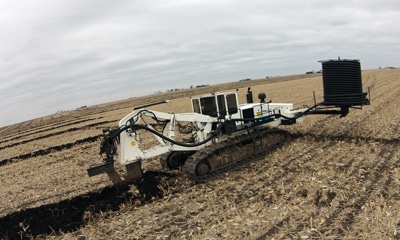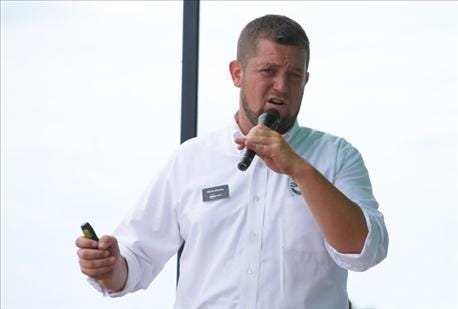
The wettest July and August on record in Illinois may have more farmers considering full-system drainage this fall. Mark Shortz, tile lead for 360 Water Solutions, says it’s important to have uniform drainage across the whole farm.
Here are a few things Shortz says farmers should keep in mind as they consider a new drainage system:
1. Remember the “why.” Before launching a new tile plan, Shortz says to keep the benefits of drainage in mind. “We’re trying to uniformly lower the water table to optimum depth,” he explains. “Properly drained soil promotes early-season root growth, allows for timely field operations and, ultimately, drives yield.”

WHY DRAINAGE MATTERS: “Properly drained soil promotes early-season root growth, allows for timely field operations and, ultimately, drives yield,” says Mark Shortz, tile lead for 360 Water Solutions. (Photo: 360 Water Solutions)
2. Resist sizing tile to fix only the “bad spots.” Even though trouble spots in fields may be obvious, Shortz advises against tiling one wet area of a field without thinking about future tiling. “Oftentimes by fixing one wet area, all you’ll do is make the area next to it the new wet spot,” he says. “We believe in a pattern-tile system from fencerow to fencerow to create uniform drainage.”
3. Tackle the full-system drainage plan one piece at a time. Shortz understands cash-flow concerns this season. However, he says farmers can still plan and execute a whole-field approach instead of fixing one problem area and potentially creating a new one. Shortz recommends developing a whole-field approach and building the system over the next few years.

NO ONE SIZE FITS ALL: What worked on your neighbor’s field may not apply to your field. Mark Shortz says while most tile systems are moving to a narrower, shallower pattern, every farm and every field is different.
4. Accept that there’s no one-size-fits-all solution. What worked on your neighbor’s field may not apply to your field. Shortz says while most tile systems are moving to a narrower, shallower pattern, every farm and every field is different. For a new full-system drainage plan, Shortz uses RTK surveys, soil types and the Illinois Drainage Guide to determine the best lateral size, spacing and depth.
For example, 4-inch tile on 60- to 80-foot lateral spacing works well on soils in east-central Illinois. In tighter soils or in river-bottom fields with a high water table, narrower laterals will help draw water off soils faster.
5. Understand how conservation and tile drainage can work together. The Illinois Nutrient Loss Reduction Strategy put tile drainage and water quality in the spotlight. Shortz believes farmers “can be good stewards of the land and have good drainage.”
The 360 Water Solutions team is currently studying two different practices recommended in the Illinois Nutrient Loss Reduction Strategy: controlled drainage and wood-chip bioreactors. Shortz says the data collected from the studies will help determine which practices are viable options, and the firsthand experience will help them advise farmers adopting these practices on their own farms.
“We’re trying to get on the forefront, get our own experience and pass it on,” he says. “We want farmers to be comfortable and confident that this [managed drainage practices] will work on their farm.”
See related: Q&A: Ivan Dozier on tillage, nutrient loss and progress
See related: 5 things you need to know about nutrient loss in Illinois
About the Author(s)
You May Also Like




